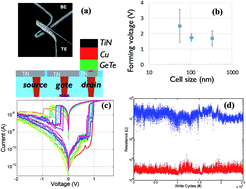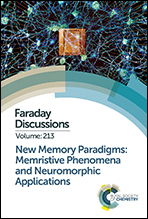Key material parameters driving CBRAM device performances
Abstract
This study is focused on Conductive Bridging Random Access Memory (CBRAM) devices based on chalcogenide electrolyte and Cu-supply materials, and aims at identifying the key material parameters controlling memory properties. The CBRAM devices investigated are integrated on CMOS select transistors, and are constituted by either Ge–Se or Ge–Te electrolyte layers of various compositions combined with a Cu2GeTe3 active chalcogenide electrode. By means of extensive physical and electrical characterization, we show for a given electrolyte system that slower write is obtained for a denser electrolyte layer, which is directly correlated with a lower atomic percentage of the chalcogen element in the layer. We also evidence that the use of Ge–Se electrolyte results in larger write energy (voltage and time), however with improved state retention properties than for Ge–Te electrolyte materials. We associate these results with the stronger chemical bonding of Cu with Se, resulting both in a stabilized Cu filament and a slower Cu cation motion. More robust processing thermal stability is also observed for Ge–Se compared to Ge–Te compounds, allowing more flexibility in the integration flow design.

- This article is part of the themed collection: New memory paradigms: memristive phenomena and neuromorphic applications

 Please wait while we load your content...
Please wait while we load your content...